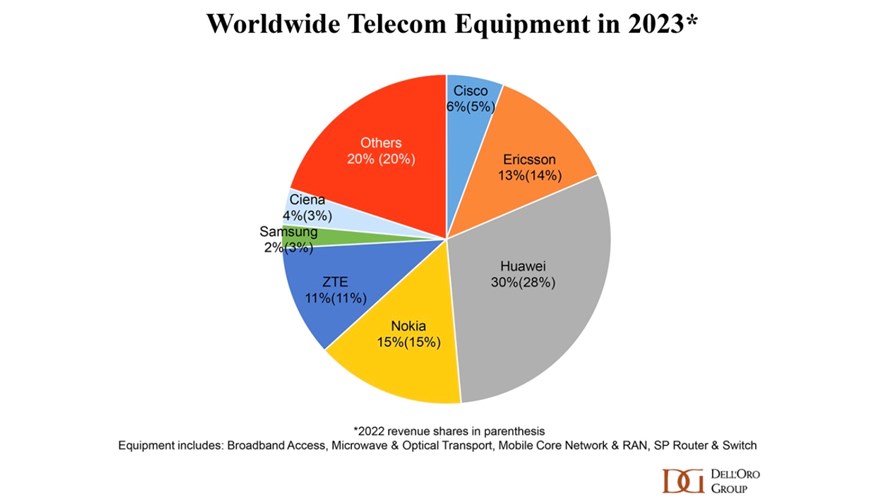
Source: Dell'Oro Group
- Telco spending on network technology dipped by 5% year on year in 2023, according to research firm Dell’Oro Group
- And it could dip further this year by as much as 5% again
- That decline in spending has been reflected in the financial woes of many in the vendor community
- Huawei is still the biggest global vendor
Vendors, brace yourselves… Confirmation that telcos have been spending less on their networks, and will shrink their capital expenditure budgets even further this year, has come from research house Dell’Oro Group, which says spending by operators on network technology products dipped by 5% year on year in 2023 after five consecutive years of increasing investments.
While the Dell’Oro team didn’t share a value for the market, its previous insights pegged the global spending in six telecom networking technology categories – broadband access, microwave transport, optical transport, mobile core network (MCN), radio access network (RAN), and service provider router and switch – at about $100bn in 2022, which puts the 2023 total at about $95bn.
Multiple factors, including the buildup of network technology inventories by network operators and supply chain issues, contributed to the reduced spending, particularly in the radio access network (RAN) and mobile core system sectors, but it wasn’t just mobile network investments that suffered a decline, noted Dell’Oro VP and analyst Stefan Pongratz in his latest blog about the telecom network equipment market. “Following a couple of years of robust PON [passive optical network] investments, operators were able to curtail their home broadband capex as well. This reduction was more than enough to offset positive developments with optical transport and SP routers,” wrote the analyst.
Major capex cuts by the top US telcos had a significant impact, explained Pongratz. “North America subsided faster than expected. Initial readings show that the aggregate telecom equipment market dropped by roughly a fifth in the North America region, underpinned by weak activity in both RAN and broadband access. On the bright side, regional dynamics were more favourable outside of the US. Our assessment is that worldwide revenues excluding North America advanced in 2023, as positive developments in the Asia Pacific region were mostly sufficient to offset weaker growth across Europe,” he noted.
While the numbers change, the vendor ranking remains pretty much the same. Helped by the significant investments of the three main operators in its domestic market, as well as its ongoing supplier relationships with network operators in many markets around the world (despite being barred in some countries for security reasons), Chinese firm Huawei Technologies is by far the biggest single vendor, with a 30% global market share, followed by Nokia with 15% and Ericsson with 13% (see the pie chart, above). It will be galling for some that Huawei has increased its share of the market, especially while the market is shrinking. The top seven vendors accounted for 80% of the global market, according to Dell’Oro’s calculations.
That network operators tightened their purse strings was apparent in the financial reports of most vendors throughout 2023 and this was hammered home by the full year reports issued by the major vendors during the first three months of this year. Not only did the likes of Ericsson and Nokia report significant year-on-year sales declines, they also warned of a challenging economic environment in 2024 – see Ericsson: 2023 was grim, 2024 isn’t looking any better and Nokia set to shrink again in 2024.
The Dell’Oro team’s outlook reflects that pessimism. “Market conditions are expected to remain challenging in 2024, though the decline is projected to be less severe than in 2023,” noted Pongratz, whose analyst team is “collectively forecasting global telecom equipment revenues to contract 0 to -5% in 2024. Risks are broadly balanced. In addition to currency fluctuations, economic uncertainty, and inventory normalisation, there are multiple regions/technology segments that are operating in a non-steady state,” noted the Dell’Oro analyst.
What that appears to mean is that it’s hard to say exactly what will happen this year in terms of telco network spending, but it’s not likely to spell good news for the vendor community.
- Ray Le Maistre, Editorial Director, TelecomTV
Email Newsletters
Sign up to receive TelecomTV's top news and videos, plus exclusive subscriber-only content direct to your inbox.




